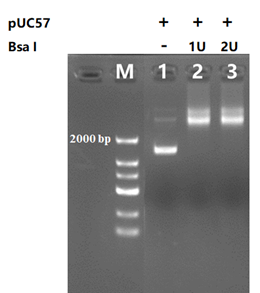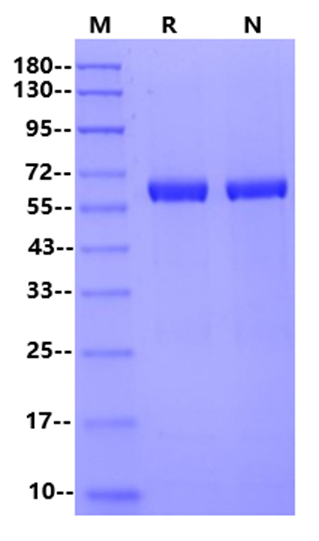Product Specification
| Species |
Bacillus stearothermophilus |
| Synonyms |
BsaⅠ 限制性内切酶 |
| Expression System |
E.coli |
| Molecular Weight |
64.9kDa (Reducing) |
| Purity |
>95% by SDS-PAGE |
| Conjugation |
Unconjugated |
| Tag |
His Tag |
| Physical Appearance |
Liquid |
| Storage Buffer |
10 mM Tris-HCl、300 mM NaCl、1 mM DTT、0.1 mM EDTA、500 µg/ml BSA、50% Glycerol (pH 7.4 @ 25°C) |
| Stability & Storage |
Store at -25 ~ -15℃
for 2 years
|
| Reference |
[1]
Zhu Z, Samuelson J C, Zhou J, et al.Engineering Strand-specific DNA Nicking
Enzymes from the Type IIS Restriction Endonucleases BsaI, BsmBI, and
BsmAI[J].Journal of Molecular Biology, 2004,
337(3):573-583.
[2] Lee J H, Won H J, Oh E S,etal. Golden Gate
Cloning-Compatible DNA Replicon/2A-Mediated Polycistronic Vectors for
Plants[J]. Frontiers in Plant Science, 2020, 11.
|
Background
BsaI
is a Type IIs restriction enzyme that can recognize non-palindromic sequences
and cut outside of the recognition sequence. It is commonly used for Golden
Gate assembly and enzymatic cleavage of plasmids to prepare linear DNA
fragments with poly (A/T/G/C) endings and obtain specific sticky ends.
Recognition
site:
5'-GGTCTC(N)1↓-3'
3'-CCAGAG(N)5↑-5'
Components
Storage
Solution: 20 U/μl BsaⅠ、10 mM Tris-HCl、300 mM NaCl、1 mM DTT、0.1 mM EDTA、500 µg/ml BSA、50% Glycerol(pH 7.4 @ 25°C)
10*Reaction Buffer:500 mM Potassium Acetate、200 mM Tris-acetate、100 mM Magnesium Acetate、1mg/ml BSA(pH 7.4 @ 25°C)
Protocol
This
step is suitable for linearization of 1 μg DNA (≥100 nt) and can be scaled up
according to experimental needs.
1)Add the following components in
sequence
|
Components
|
Volume
|
Plasmid DNA
|
1μg DNA
|
10*Reaction Buffer
|
5μl
|
BsaⅠ (20 U/μl)
|
1μl
|
RNase-free ddH2O
|
Up to 50μl
|
2)Incubate at 37°C 1h
3)DNA linearization is
complete, and subsequent experiments can be performed.
Guidelines
1. star activity may result from a glycerol concentration of >5%; 2. Please avoid repeated freeze-thaw cycles.
Unit Definition
One unit is defined as the amount of enzyme required to digest 1 µg of pXba DNA in 1 hour at 37°C in a total reaction volume of 50 µl.






